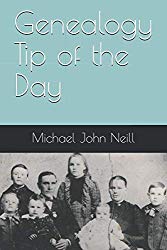Maybe it’s time we had a “Genealogical Budget Standard.”
After all, we have a “Genealogical Proof Standard” and a variety of other terms and definitions created by professionals, accrediting bodies, etc.
But sometimes, amid all the theory, reality rears its ugly head. I can’t afford a copy of every document. I understand why getting as many copies of things is genealogically prudent. There can always be a “new clue” in an unexpected place. I also understand that the Genealogical Proof Standard does not always mean that we get everything, but it does suggest that we obtain what would reasonably answer our question.
But what if Mr. Ima Really Confusingancestor and four ancestral siblings and ten first cousins all served in the Mexican War and all got pensions? That’s a pricey sum to obtain copies of all those records in hopes that one provides the clue that I need. Of course, I’d obtain first the file on Ima as it may provide good information. I might try next and get any files where the widow lived the longest as those tend to contain more information. I might look at any applications that were denied, contested, or resulted in a special examiner being sent to obtain evidence as those cases tend to have more detail.
But determining where to draw the line when I can’t afford it all–that’s the problem.
Maybe I need a personal Genealogical Budget Standard.
We can call it Genealogical BS.

5 Responses
I couldn’t agree more. Common sense should prevail. My “reasonably exhaustive” budget is also a consideration.
Love the phrase “Genealogical Budget Standard.”
Thanks. I weigh cost/benefit with quite a few records that I get. While I fully understand looking at more than a few records (particularly not only using one), sometimes the costs do add up.
And for my ancestors, if I can find one document at all I do the happy dance! Not everyone can get enough documentation to use the standard. ALL of my ancestors lived in places with no records, sometimes for 2 or 3 generations. I’ve decided I don’t care. I’ll gather my family history and be very happy that someone in my family did that much. So what if it doesn’t meet someone’s criteria of “Genealogy”.
I’m inclined to agree. There’s only so much time and so much money. Sometimes I’m lucky to get one record–let alone several. The best bet is to get what you can, transcribe it accurately, determine what it says, reach conclusions based upon that and move on. If there are records that I’ve not been able to obtain or have searched, mentioning that isn’t a bad idea either–so at least others know that there “might be more out there.” But sometimes it’s not always practical to search for something if there’s a very slight chance it might contain a new detail.
Then there’s always that chance that the record you really wanted/needed is riddled with erroneous information. When working on my DAR application I needed copies of the original documents of my parents, grandparents and great-grandparents. Well, my parents, that was easy and my grandmother’s birth certificate and grandparent’s marriage certificate was easy as well. Then came my great-grandmother, Marietta!!! It turns out she was married before marrying my great-grandfather. Marietta never divorced her first husband, Ray Hayes. I never took a real close look at her original marriage certificate to my great-grandfather, Fred Stanley, which I had received with a bunch of papers from my grandmother. The marriage date was altered from 10 Jun 1918 to 10 Jun 1908. My grandmother was born 14 Apr 1911. Fred used to call Marietta, “Hazy”. Her children thought her maiden name was Hayes. Her daughter who gave the information for her death certificate when asked for the father’s full name stated “Fred Stanley” (should have been James Wallace) and mother’s full maiden name “Marietta Hayes” (should have been Georgia Briggs). Her daughter thought they meant her parents names. LOL. Back to my grandmother, she actually was the child of Fred and Marietta, but took a lot of work to prove it. Marietta was pregnant (at age 15) and they had eloped. Her mother went after them and was going to have the marriage annulled, and Ray arrested. When she found out Marietta was pregnant, she lied to the priest about Marietta’s age (said she was 16) and had them married. The baby was stillborn and buried in potter’s field in Catholic Cemetery (as the baby was not baptized) where Ray’s family had plots. At that point Marietta and Ray parted ways, but they never had the marriage annulled or divorced. Ray married a girl in Michigan. They later divorced and I found him in the 1910 census working as a painter in Kansas. Marietta was living alone in a boarding house in Chicago in 1910. Fred was listed as the father on my grandmother’s birth certificate 4 Apr 1911 and they were living at the same boarding house as Marietta was in 1910. Funny thing was, they never married until after they had their fourth child and just before he had to register for the draft for WWI.